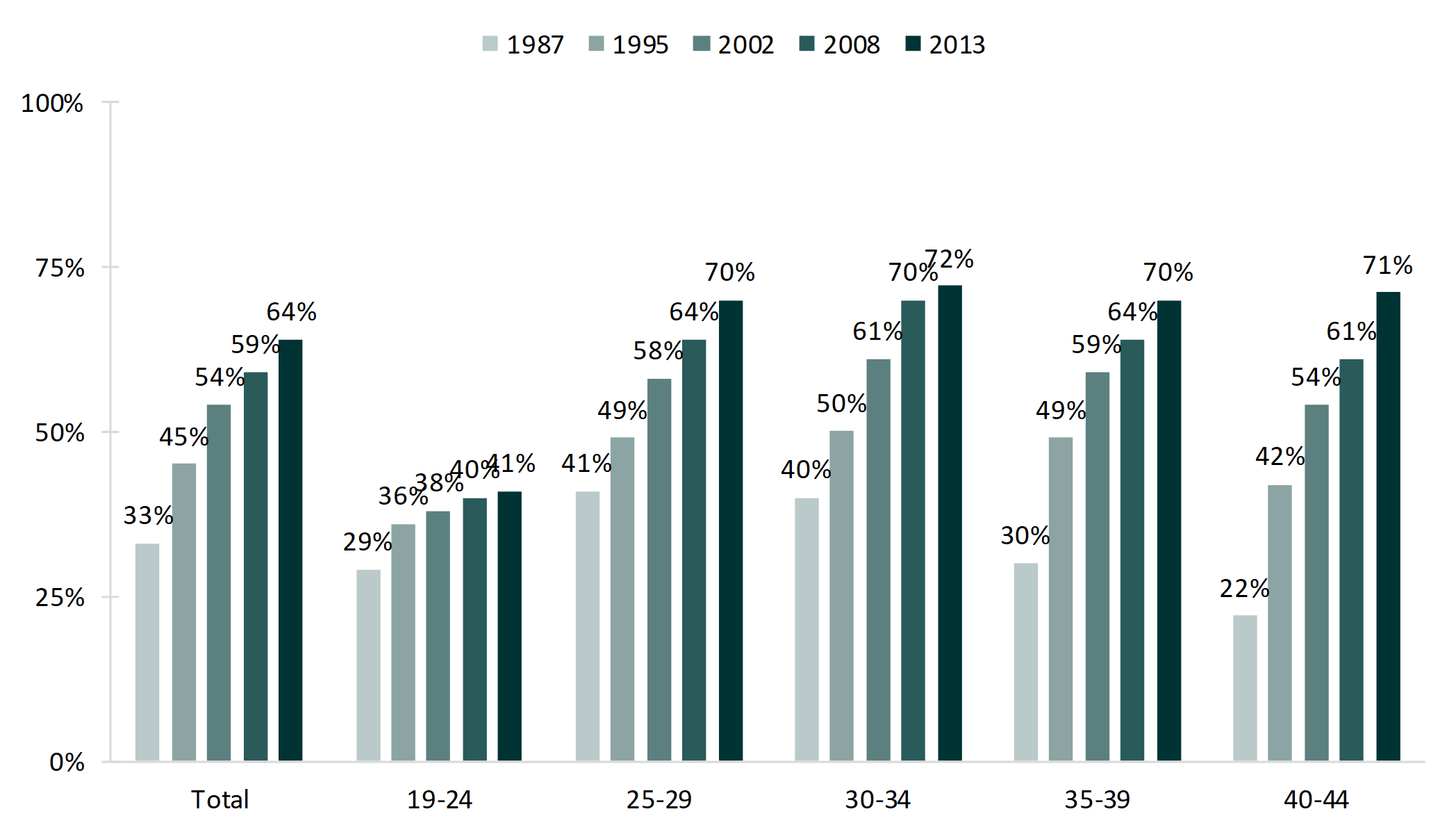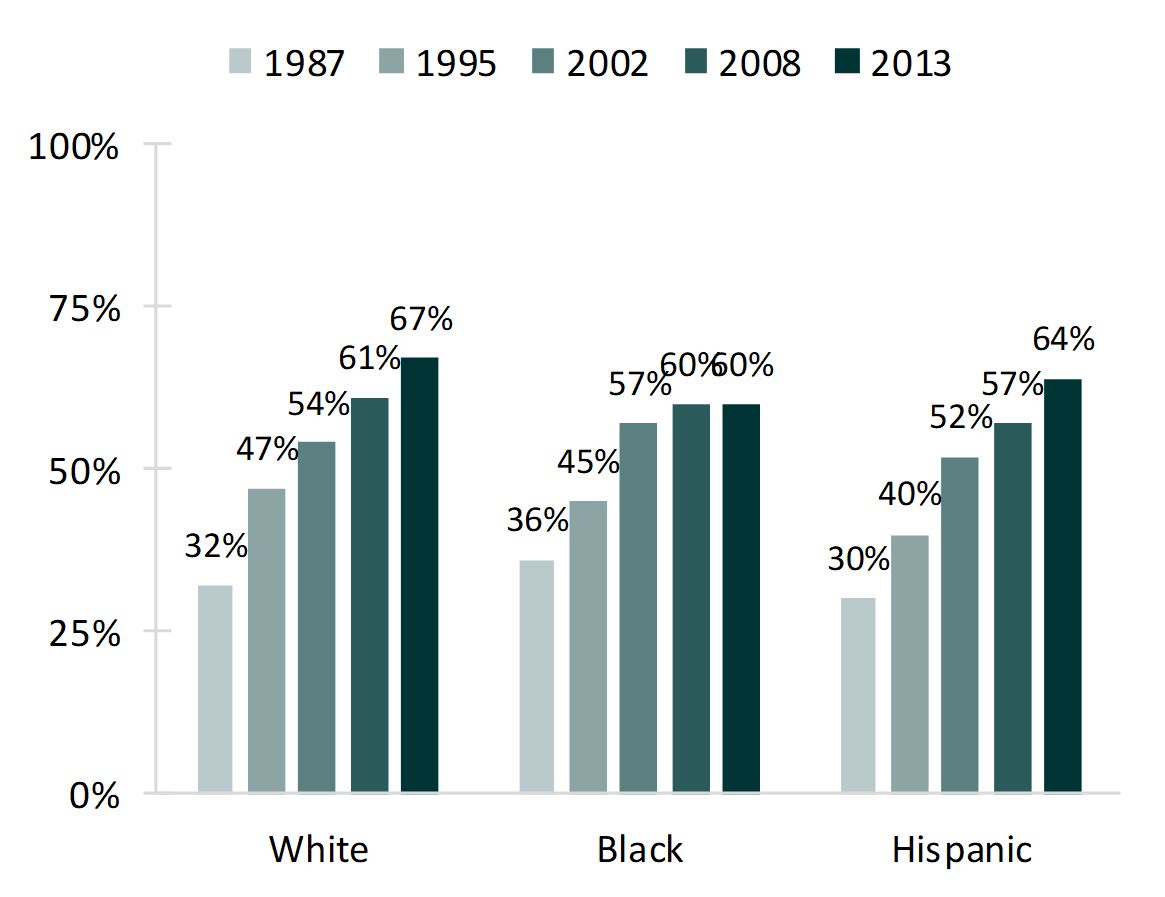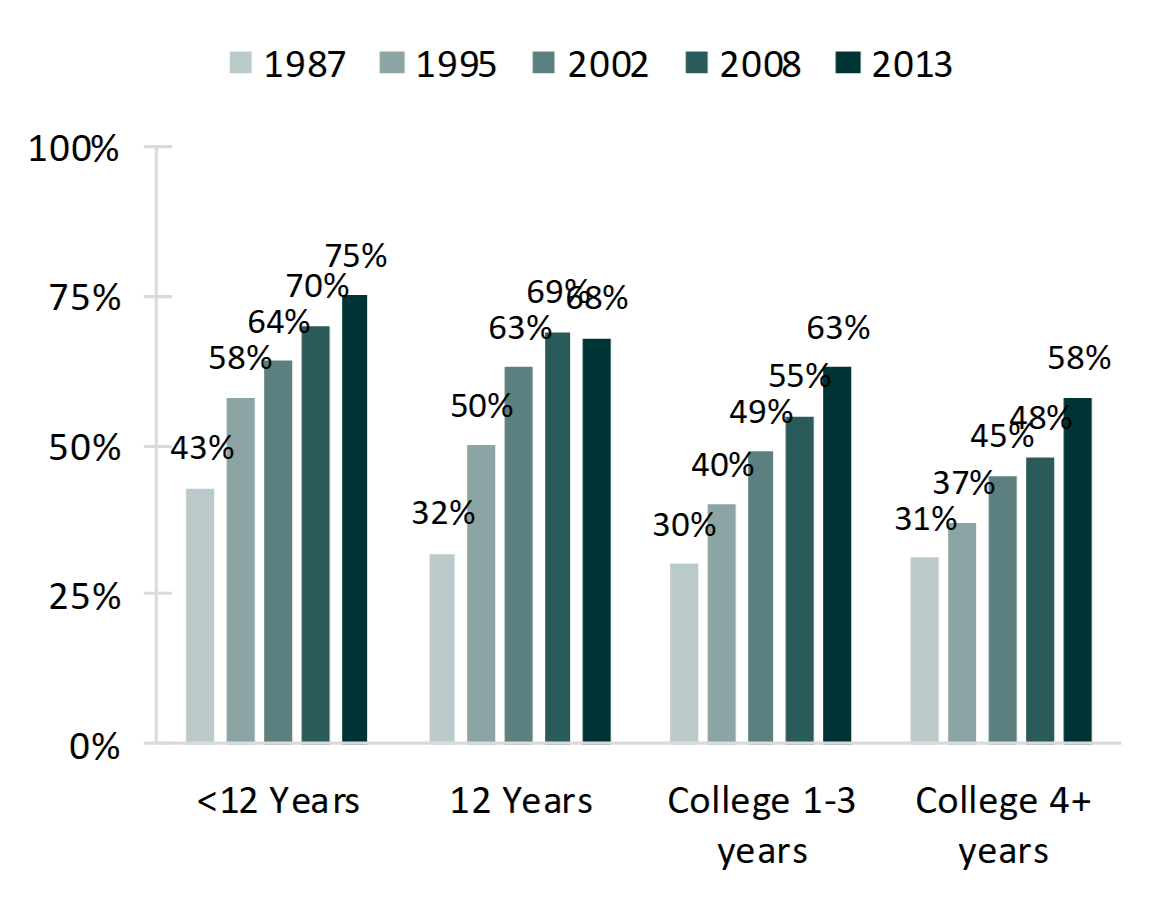Over Twenty-Five Years of Change in Cohabitation Experience in the U.S., 1987-2013
Family Profile No. 2, 2017
Authors: Paul Hemez & Wendy D. Manning
This Family Profile documents shifts in the percentage of women who have ever cohabited over the past quarter century (1987 to 2013). Due to the relatively short duration of cohabiting unions (about 28 months), it is important to examine changes in women's experiences of cohabitation and not just their status at the time of interview (Lamidi, Manning, & Brown, 2015). To provide nearly three decades of cohabitation trends, we draw on two published articles (Bumpass & Lu, 2000; Kennedy & Bumpass, 2008) and our own updated analyses using the National Survey of Family Growth (NSFG). Estimates for 2008 are gathered from the 2006-2010 cycle, and estimates for 2013 are computed with the newly released 2013-2015 cycle in combination with the 2011-2013 NSFG. For more information on the NSFG, see the 2013-2015 Cycle of National Survey of Family Growth and the NSFG web page.
Changes in the Percentage of Women Who Ever Cohabited
- The percentage of women who have ever cohabited nearly doubled between 1987 and 2013. In 1987, one-third of women (aged 19-44) had ever cohabited, and in 2013, nearly two-thirds (64%) of women had cohabitation experience.
- The share of women who have ever cohabited increased across all age groups. The greatest increase was among women aged 40-44, whereas the smallest increase occurred among women aged 19-24.
- Women between the ages of 30 and 34 experienced the highest levels of cohabitation; nearly three-fourths (72%) had ever cohabited as of 2013.

The percentage of women who have ever cohabited nearly doubled between 1987 and 2013.

Figure 1. Change in the Share of Women (19-44) Who Ever Cohabited, by Age at Interview

Race & Ethnicity
- The share of women who had ever cohabited increased for all women regardless of race/ethnicity between 1987 and 2013. There has been more than a doubling among Hispanic and White women, with a slightly lower level of growth among Black women.
- In 2013, over two-thirds (67%) of White women had ever cohabited compared to 60% of Black women and 64% of Hispanic women.
- Over the last decade, the share of Black women with cohabitation experience has leveled, only increasing from 57% in 2002 to 60% in 2008 and remaining at 60% in 2013.
Figure 2. Change in the Share of Women (19-44) Who Ever Cohabited, by Race and Ethnicity Status

Educational Attainment
- From 1987 to 2008, the share of women aged 19-44 who had ever cohabited steadily increased among all educational attainment groups. This share continued its increase into 2013 for all groups except those with a high school diploma or GED.
- By 2013, the majority of women - regardless of educational attainment - had cohabited at least once.
- Over the past 26 years, cohabitation has consistently been highest among women with less than a high school degree; in 2013, three-quarters of these women had ever cohabited.
- Women with the highest levels of education, on the other hand, consistently reported? the lowest percentage of cohabitation experience; most recently, 58% of women with a college degree had ever cohabited.
Figure 3. Change in the Share of Women (19-44) Who Ever Cohabited, by Educational Attainment

References
- Bumpass, L., & Lu, H. (2000). Trends in cohabitation and implications for children's family contexts in the United States. Population Studies, 54, 29-41. doi: 10.1080/713779060
- Kennedy, S., & Bumpass, L. (2008). Cohabitation and children's living arrangements: New estimates from the United States. Demographic Research, 19, 1663-1392. doi: 10.4054/DemRes.2008.19.47
- Lamidi, E. 0., Manning, W. D., & Brown, S. L. (2015). Change in the stability of first premarital cohabitation, 1980-2009 (Working Paper WP-2015-26). Retrieved from Center for Family and Demographic Research website: https://www.bgsu.edu/content/dam/BGSU/college-of-arts-and-sciences/center-for-family-and-demographic-research/documents/working-papers/2015/WP-2015-26-v2-Lamidi-Change-in-Stability-of-First-Premarital-Cohabitation.pdf
Suggested Citation
- Hemez, P., & Manning, W. D. (2017). Over twenty-five years of change in cohabitation experience in the U.S., 1987-2013. Family Profiles, FP-17-02. Bowling Green, OH: National Center for Family & Marriage Research. http://www.bgsu.edu/ncfmr/resources/data/family-profiles/hemez-manning-25-years-change-cohabitation-fp-17-02.html

This project is supported with assistance from Bowling Green State University. From 2007 to 2013, support was also provided by the U.S. Department of Health and Human Services, Office of the Assistant Secretary for Planning and Evaluation. The opinions and conclusions expressed herein are solely those of the author(s) and should not be construed as representing the opinions or policy of any agency of the state or federal government.
Updated: 04/21/2021 09:27AM

